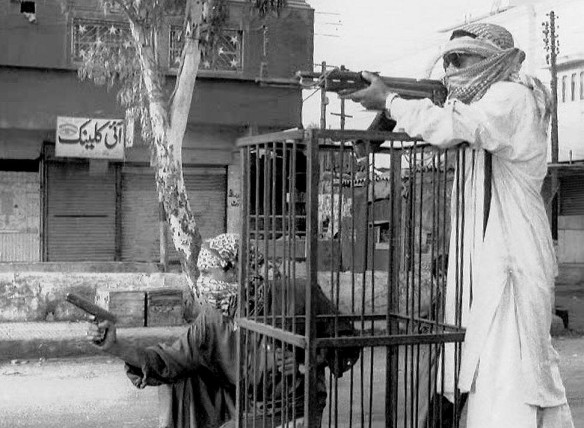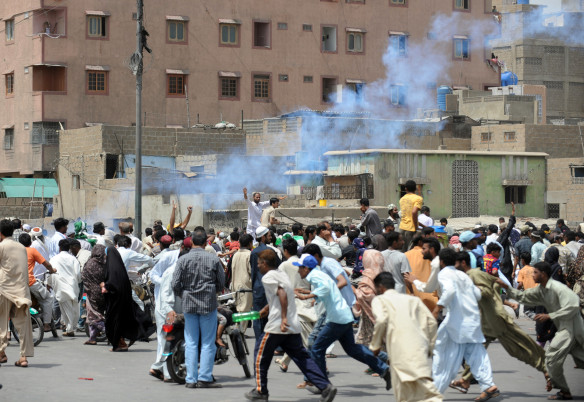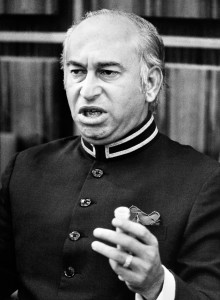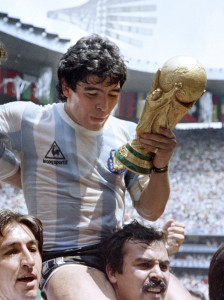Inner City Chronicle
By Ali Arqam | News & Politics | Published 9 years ago
Lyari is today a sad reminder of the past. Infested with criminal gangs, its old buildings pock-marked by bullets, its streets a roller-coaster ride because of the craters left by rocket launcher hits, homes derelict, abandoned by third and fourth generation Lyari inhabitants, and a terror-struck population that remains — many of them the mothers of fallen sons and the children of fathers mowed down — the Lyari story is a sad, sorry one.
The forced migration of Lyari’s indigenous communities like the Katchis, Memons, Ghanchis, Bohris, Hindus and scheduled castes such as the Meghawars, is reminiscent of another time and place. The image of fleeing families, carrying with them their aged and infirm, small children and possessions, could be a page from Partition.
So what went wrong? Veteran journalist Khaled Ahmed calls Lyari “the graveyard of governance.” But perhaps avarice and the lust for power are as much to blame as is the unbridled corruption of the local authorities and the lack of governance.
At the height of the political violence in Karachi in the mid ’90s, only a few journalists and news publications dared to report the atrocities committed by the law enforcement agencies (LEAs) in the course of ‘Operation Clean Up’ being conducted against the warring factions of the Muttahida Qaumi Movement (MQM). But the violence witnessed at the hands of the law-enforcement personnel was matched by that unleashed by the mainstream MQM and the thugs of its breakaway faction, Haqeeqi. And that chapter in history forms part of one of the grisliest moments in the annals of Karachi’s existence. No one was immune. Pakistan Peoples Party workers and non-partisan residents of the city were also either targeted or became random victims of the violence.
It was during those years, that author and publisher Ajmal Kamal published two special volumes of the Urdu periodical Aaj under the title ‘Karachi ki Kahani’ (The story of Karachi). These were anthologies of essays, stories and research articles on Karachi, its past history, and the issues and problems which had led to the present mess.
But while these books offer an insightful view of Karachi and help explain the genesis of the violence in the city, they lack one significant detail: the story of Lyari and its gangs.
Kamal explained the absence of Lyari from his work saying, “Lyari was a peaceful place in those days. Criminals existed, but they were essentially dealers of smuggled goods, hashish and alcohol. They abstained from violence.”
 Author and poet Hasan Mujtaba made up for Kamal’s lapse. In an article published in Newsline in 1997, he asked, “What is Lyari? The kick of a footballer, the fist of a boxer, the clip-clop of a tonga, the braying of donkey, the smell of fish and hashish. Dry water taps and tearful eyes, a police beating (perhaps, even killing), a looting at dagger or gunpoint in a dark alley. A labyrinth of narrow alleys, streaming gutters and broken roads.” And journalist Nadir Ali Shah Adil said about his native Lyari, “It’s a land of magic, a zoo of hundreds of thousands of human beings.”
Author and poet Hasan Mujtaba made up for Kamal’s lapse. In an article published in Newsline in 1997, he asked, “What is Lyari? The kick of a footballer, the fist of a boxer, the clip-clop of a tonga, the braying of donkey, the smell of fish and hashish. Dry water taps and tearful eyes, a police beating (perhaps, even killing), a looting at dagger or gunpoint in a dark alley. A labyrinth of narrow alleys, streaming gutters and broken roads.” And journalist Nadir Ali Shah Adil said about his native Lyari, “It’s a land of magic, a zoo of hundreds of thousands of human beings.”
Those were undoubtedly the good old days of Lyari, when it was known for its athletes, its political and social activism and its unyielding love for the Bhuttos. But as Mujtaba wrote, “Lyariities mourned the death of the Bhuttos, but mourned equally when Brazil lost the soccer World Cup.” While referring to Baghdadi, that part of Lyari dominated by Sheedis, he observed, “Here Maradona (the legendary footballer from Argentina, who had a cult following in the’80s and ’90s) and the Bhuttos are equally revered.”
But Lyari also had other heroes. After Partition and the multiple waves of migration across the border, Karachi became home to myriad ethnic communities. Lyari served as a middle point between the old city, the business centres and the newly inhabited localities, and gradually, it too embraced old and new settlers.
“Lyari was not only home for the Baloch living there for hundreds of years, or those who moved from Balochistan more recently, it also embraced the poor and impoverished among the migrants from India, collectively known as Biharis, alongside traders and businessmen from Khyber Pakhtunkhwa and the Afghan provinces, and also the Punjabis and Hindko-speaking from Hazara division, Attock and the Potohar region,” says Haji Ghulam Qadir, a long-term resident of Lyari’s Koila Godam, later renamed Gulistan Colony.
And during the worst ethnic violence between the Mohajirs and Pashtuns, against the backdrop of the Sohrab Goth evacuation and the Aligarh Bazaar massacre, the cosmopolitan nature of Lyari remained intact, with all ethnic groups equally at home there, secure in the belief that the population could not be polarised on an ethnic basis.
“Lyari has faced political oppression, arrests and torture during dictatorial regimes for its support to democratic forces, namely the PPP, but it was never subject to the kind of violence committed by the MQM and its rival groups in other parts of Karachi,” says Gohram Baloch, a political activist from Lyari.
It was during the days of General Pervez Musharraf that things changed. Skirmishes and rivalries between the increasingly armed groups of drug lords like Rehman Dakait and Haji Lalu and his son Arshad Pappu grew fiercer and violence became endemic in Lyari.
Rehman Dakait was the scion of Dadal, a gangster who along with his brother Sheru rose to prominence in the ’60s. Later, new characters like Haji Lalu and Babu Dakait emerged. Rehman had, at an early age, joined hands with Haji Lalu, and he together with Lalu’s son, Arshad Pappu, and another criminal, Arafat, eliminated Lalu’s rival Babu, his sons and gang members.
In early 2000, a dispute over finances pitted Rehman against Lalu and his sons, and a deadly war for control of Lyari began. In the course of this war, approximately 800 people fell prey to the violence that erupted.
Rehman Dakait’s early bids to make his way into politics were not successful as he failed to get candidates of his choice elected in the 2001 Local Bodies elections against those of the PPP-backed panels. His rivals from the Arshad Pappu gang meanwhile, sought the support of the MQM which was at the helm of affairs during Musharraf’s rule, and had managed to secure key ministries in the coalition government along with the Pakistan Muslim League (PML-Q). They had also won the local government elections.
 Aware of the danger a Pappu-MQM alliance could pose, Rehman began to make inroads in the PPP and managed to establish connections with its local leadership. Further, he sought a career in social work, establishing for this purpose, the Peoples Aman Committee (PAC) in 2007. Since Arshad Pappu was in jail, Rehman struck a truce with Ghaffar Zikri, one of Arshad Pappu’s strongest allies. The PAC was neither an ethnic group, nor did it have support within a particular locality. Though it was dominated by the Baloch, it also had Pashtuns, Seraikis, Katchis and Hindko-speaking criminals in its ranks.
Aware of the danger a Pappu-MQM alliance could pose, Rehman began to make inroads in the PPP and managed to establish connections with its local leadership. Further, he sought a career in social work, establishing for this purpose, the Peoples Aman Committee (PAC) in 2007. Since Arshad Pappu was in jail, Rehman struck a truce with Ghaffar Zikri, one of Arshad Pappu’s strongest allies. The PAC was neither an ethnic group, nor did it have support within a particular locality. Though it was dominated by the Baloch, it also had Pashtuns, Seraikis, Katchis and Hindko-speaking criminals in its ranks.
Meanwhile, the MQM continued to extend support to the Pappu gang, and also tried to widen the gap between the PPP and its sympathisers among the Katchi community of Lyari who were on the receiving end of the criminal activities and violence perpetrated by the PAC.
In 2009, when Rehman Dakait was killed in an allegedly staged encounter, his death was feted by the MQM and the police officers involved were rewarded by the Sindh governor. The very next day, when Rehman’s funeral procession was passing through Baldia Town — an MQM-dominated area — it was attacked, resulting in the death of three men. Eight others were injured. This was one of the earliest direct encounters between the PAC and the MQM.
Uzair Jan Baloch, who was once the political face of the Rehman Dakait gang and had contested Local Bodies elections against Rauf Baloch of the PPP, emerged as Rehman’s successor and started by accusing Rauf Baloch, the former UC Nazim from PPP, of conspiring against Rehman and getting him killed.
In 2010, a few days before Eid, five Baloch teenage boys on a shopping trip went missing from the area around Zainab Market in Saddar. Their bullet-riddled bodies were found the next day. Suspicion immediately fell on the MQM. This sparked outrage and resulted in retaliatory violence from the PAC. Soon video footage of the tortured bodies of young Mohajir boys — allegedly forcibly abducted from buses in Lyari — started making rounds on the internet.
Already engaged in armed conflicts with the ANP in different areas of Karachi since November 2008, the MQM had now invoked a full-fledged battle with the PAC.
The battle was to become a veritable war. And in the process, Lyari, writer Adil’s magical “zoo of hundreds of thousands of human beings” became a jungle, where beasts of every nature seemed to have been set free.
Gradually, the community that once was ceased to exist as one group turned against the other. A scrap dealer from Shershah disclosed, “the loyalty of many of the Baloch labourers, long working with local traders and scrap dealers, became eroded. They began to spy on their seths. As a result many of the latter started to receive calls from PAC heavyweights demanding huge amounts as extortion.”
When the PAC faced a split and turned on each other, the situation became worse. No one anywhere was safe. As a result, thousands fled their homes, migrating to other parts of Karachi, with the affluent moving to settlements like Haroon Bahria Housing Society, Malir and Raees Ghulam Sarwar Goth, while the less privileged sought shelter in the informal settlements of Baldia Town and Orangi Town. Dozens of other families meanwhile, moved to Hub Chowki, Lasbella, the bordering town of Balochistan, and thousands of members of the Katchi community moved to Thatta and Badin districts of Sindh.

 Those that did not — or could not — move, lived in constant fear. And while conditions have improved, life remains uncertain. Lyari residents say that although a semblance of peace has returned to Lyari, it is still a long way from being the safe haven of their past.
Those that did not — or could not — move, lived in constant fear. And while conditions have improved, life remains uncertain. Lyari residents say that although a semblance of peace has returned to Lyari, it is still a long way from being the safe haven of their past.
“We have witnessed the viciousness of the PAC and still have to face the stigma of residing in a crime-infested locality. It reduces our job opportunities in any reputable business enterprise, as the address on our resumé is more than enough to alarm them,” lamented a Lyari-based student of business administration in a private university. “For the less educated, the illiterate and even skilled labour, the chances of getting jobs even as helpers at shops and markets in the old city in places like the Shershah scrap market and the auto parts market, which are located at walking distance from many parts of Lyari, are virtually impossible.”
Another trader added, “Until, the entire network of gangs is dismantled, people will not stop suspecting the labourers, skilled workers and even donkey cart owners.”
In meetings held in the beginning of February, the police decided to further intensify the ongoing operation against criminal gangs, terrorists and their facilitators in Lyari and made several arrests. Hasan Dada alias Gulabo, an estranged commander of the Ghaffar Zikri gang, was among those arrested from Daryabad, Lyari. However, many of the PAC ringleaders, such as Shiraz Comrade, Faisal Pathan, Mulla Nisar, Taj alias Taju, Wasiullah Lakhu and PAC’s arch-rival Ghaffar Zikri among others, are still at large. There are reports that red warrants of arrest will be soon issued by the Federal Investigation Agency for these men.
Only time will tell if Lyari can be rehabilitated. But after years of trauma, the area’s residents, long waiting to exhale, are breathing easier. For those who have left, however, there is still no going back.
This article was originally published in Newsline’s March 2016 issue.
Ali Arqam main domain is Karachi: Its politics, security and law and order


